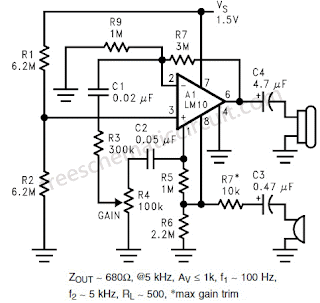The reference, with a 500 kHz unity gain bandwidth, is used as a preamplifier with a gain of 100. Its output is fed through a gain control potentiometer to the op amp which is connected for a gain of 10. The combination gives a 60 dB gain with a 10 kHz bandwidth, unloaded, and 5 kHz loaded at 500 Ohm. Input impedance is 10 kOhm. Potentially, using the reference as a preamplifier in this fashion can cause excess noise. However, because the reference voltage is low, the noise contribution, which adds root mean square, is likewise low. Here is a schematic drawing:
One point to observe with this connection is that the signal swing at the reference output is strictly limited. It cannot swing much below 150 mV nor closer than 800 mV to the supply. Further, the bias current at the reference feedback terminal lowers the output quiescent level and generates an uncertainty in this level. These facts limit the maximum feedback resistance (R5) and require that R6 be used to optimize the quiescent operating voltage on the output. Even so, the fact that limited swing on the preamplifier can reduce maximum output power with low settings on the gain control must be considered.
In this design, no DC current flows in the gain control. This is perhaps an arbitrary rule, designed to insure long life with noise free operation. If violations of this rule are acceptable, R5 can be used as the gain control with only the bias current for the reference amplifier (<75 nA) flowing through the wiper. This simplifies the circuit and gives more leeway on getting sufficient output swing from the preamplifier.

No comments:
Post a Comment